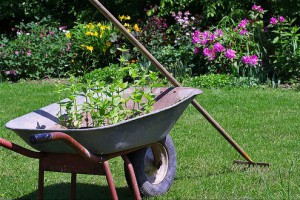 My husband and I love nature and spend all weekends at the cottage. In the first years, a lot of strength and money went on the processing of land, fertilizer, spraying. Earth, the garden from this did not become better. When we drew attention to abandoned gardens, they realized that we were doing something wrong. They were no worse, but to say more precisely, it looked even "healthier" .. no one sprayed there, did not remove the leaves from under the trees, did not water.
My husband and I love nature and spend all weekends at the cottage. In the first years, a lot of strength and money went on the processing of land, fertilizer, spraying. Earth, the garden from this did not become better. When we drew attention to abandoned gardens, they realized that we were doing something wrong. They were no worse, but to say more precisely, it looked even "healthier" .. no one sprayed there, did not remove the leaves from under the trees, did not water.
How often it happens in new gardening, we also had a problem with water. And we began to think how to use water more efficiently. Started with the fact that they began to mulch tomatoes and cucumbers beveled herbs, slipped weeds and understood - this is a way out.
For a couple of years, we worked out our cultivation technology with minimal costs. If short, then everything comes down to preliminary planning of future landings. In August (after harvesting garlic and onions), sow rye - the next year tomatoes will grow there. In October, we make marking and swallow rows under culture. In the aisle, rye grows up to spring. A week before the disembarkation, for example, tomatoes weigh rye and put it on the ranks. The land is covered and does not dry. After disembarking, crops are well water and mulch the decent layer of this straw. The aisle (due to the roots of rye do not overgrow weed) do not require a musting and after the rain there is not dirty walking. Camvices work under the mulch - the soil loose and we also do not need to be so.
Pour the culture as needed (I poured the water directly on the mulch) - the earth does not dry up for a long time. We liked this technique so much that we began to mulch everything: and trees, and grapes. This year they clicked even strawberries.
In the spring we are not in a hurry to sweat sumbling. Ground, he also goes to mulch. Additionally, we offer grass on abandoned areas. In the fall, all this is drunk and thereby feels soil. Under the trees, the Earth turned into a great fertile layer. There, we also sow rye and weigh spring. Weeds do not grow and soil does not dry.
Now we have enough water, and the crops have become better, and the savings - do not waste fertilizer. And most importantly, it is not necessary to run with a roast, which is also important for older people.













I know that the cuttings of the gardeners are always needed. They are used to vaccinate in winter, and in the spring are suitable for improving imports in the event of an unsuccessful eyepling. Let me remind you to emblooked - it means to put on one plant of the enemy's eyes.
Open secret - the shanks harvested after the first cold (-10 °), well-tempered. I take the long (30-40 cm) increments the current year, with advanced kidney disease-free.
Try not to spoil the skeleton of the crown of the tree, which gives you the cuttings.
Once, shoots from the same tree, so immediately hang a label and placed in a bag made of synthetic fabric, and then move on to the next tree. After finishing sections cuttings attribute them in batches into the basement, where the temperature close to 0 °.
Well, the last. Before you take the secateurs, carefully consider exactly what you need cuttings. Cutting all do not need without discrimination.
Adopt experience of growing seedlings, to combat various pests of garden and vegetable garden with friends and acquaintances, and that's decided to share his experience.
Summer last year, was pleased to be extremely rich harvest. Branches of apple, plum, sloe garden bent to the ground, and if not set props, a lot of harvest would not matured, and the trees would not be good.
But as we tried, one tree we could not keep from cracking. Large shrub garden thorns broke in half. Throw unripe fruits of pity and decided to put it in a large bucket of water.
Continuing poured water. Bush is not povyal and fruit slowly ripened. So at the end of August we collected a bucket of ripe berry tart. If you have a similar situation - boldly doraschivat harvest.